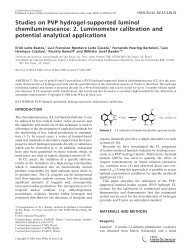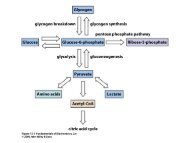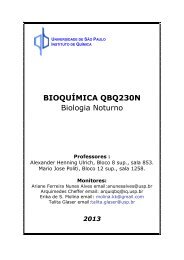The development of strategies for terpenoid structure determination
The development of strategies for terpenoid structure determination
The development of strategies for terpenoid structure determination
Create successful ePaper yourself
Turn your PDF publications into a flip-book with our unique Google optimized e-Paper software.
isopentenyl pyrophosphate. This is undergoing a resurgence<strong>of</strong> interest as a consequence <strong>of</strong> the discovery <strong>of</strong> the nonmevalonatedeoxyxylulose pathway to <strong>terpenoid</strong> compounds. 118<strong>The</strong> second stage involves the stepwise polymerization <strong>of</strong> theisoprene units to <strong>for</strong>m the acyclic polyprenyl precursors <strong>of</strong> the<strong>terpenoid</strong>s such as geranyl, farnesyl and geranylgeranyl pyrophosphate.<strong>The</strong> third stage involves the cyclization <strong>of</strong> these t<strong>of</strong>orm the underlying carbon skeleta <strong>of</strong> the various families <strong>of</strong>terpenes and the final stage involves establishing the sequenceand stereochemistry <strong>of</strong> the various hydroxylations and oxidationswhich lead to the individual families <strong>of</strong> <strong>terpenoid</strong> naturalproduct. Whilst it is not the purpose <strong>of</strong> this review to give anaccount <strong>of</strong> the <strong>development</strong> <strong>of</strong> <strong>terpenoid</strong> biosynthesis, it isimportant to note that these studies have had a significantimpact on <strong>terpenoid</strong> <strong>structure</strong> elucidation. Implicit in thesequences <strong>of</strong> the later stages <strong>of</strong> many <strong>terpenoid</strong> biosynthesesare a number <strong>of</strong> ‘missing’ links. This has provided the stimulus<strong>for</strong> the careful examination <strong>of</strong> extracts in order to identifythe relevant compounds, the structural characteristics <strong>of</strong>which could be predicted from the biogenetic speculation. <strong>The</strong>study <strong>of</strong> the biosynthesis <strong>of</strong> the gibberellin plant hormones 105and <strong>of</strong> many sesqui<strong>terpenoid</strong> fungal metabolites, such as those(e.g. 73) <strong>of</strong> Botrytis cinerea, 119 provide examples <strong>of</strong> this. <strong>The</strong>need to prepare labelled compounds has also led to a reinvestigation<strong>of</strong> various aspects <strong>of</strong> degradative chemistry. <strong>The</strong> use <strong>of</strong>carbon-13 labelled precursors has provided the stimulus <strong>for</strong> theassignment <strong>of</strong> the carbon-13 spectra <strong>of</strong> <strong>terpenoid</strong> naturalproducts whilst the <strong>development</strong> <strong>of</strong> specialized biosynthetictechniques such as the use <strong>of</strong> inhibitors and <strong>of</strong> plant tissueculture has led to the isolation <strong>of</strong> novel <strong>terpenoid</strong> naturalproducts.An understanding <strong>of</strong> the pathways can lead to a rationalization<strong>of</strong> the role <strong>of</strong> various functional groups in a <strong>terpenoid</strong><strong>structure</strong>. Thus a hydroxy group or a double bond may be theconsequence <strong>of</strong> a cyclization step, it may be the structural code<strong>for</strong> a particular biosynthetic sequence or it may be part <strong>of</strong> the‘dumping’ or ‘control’ mechanism <strong>of</strong> biosynthesis.18 <strong>The</strong> role <strong>of</strong> NMR spectroscopyVery early in the application <strong>of</strong> NMR spectroscopy to structuralproblems, it became apparent that changes in the chemicalshift and multiplicity <strong>of</strong> signals consequent upon chemicalchanges provided useful methods <strong>of</strong> assigning signals and interrelatingprotons. Since many <strong>terpenoid</strong> natural products occurin plants in groups differing only in the number and position <strong>of</strong>hydroxy groups or esters, the changes in spectra associated withchanges in functionality provided the means <strong>of</strong> establishing the<strong>structure</strong>s <strong>of</strong> groups <strong>of</strong> natural product. Thus there was achange in the 1960’s from investigations which concentrated onthe <strong>structure</strong> <strong>of</strong> one natural product to those which elucidatedthe <strong>structure</strong>s <strong>of</strong> a number <strong>of</strong> related compounds. This change<strong>of</strong> strategy is exemplified by the studies on the sesqui<strong>terpenoid</strong>lactones. It facilitated a number <strong>of</strong> phytochemical surveysexemplified by the work on the Compositae and the Labiataeand when coupled with UV spectroscopy, on the work on thepigments <strong>of</strong> the Coleus and Plectranthus species. 120 <strong>The</strong> recognition<strong>of</strong> characteristic features in the NMR spectra <strong>of</strong> <strong>terpenoid</strong>natural products facilitated the identification <strong>of</strong> the manyclerodanes found in the Labiatae, some <strong>of</strong> which are insectantifeedants. 121 <strong>The</strong> branched chain nature <strong>of</strong> the isoprene unitleading to the generation <strong>of</strong> a quaternary methyl group bytypical <strong>terpenoid</strong> cyclizations and furan rings from the terminalisoprene units were helpful in this context.<strong>The</strong> application <strong>of</strong> Fourier trans<strong>for</strong>m methods to the recording<strong>of</strong> 13 C NMR spectra meant that useful data could be collected<strong>for</strong> a range <strong>of</strong> <strong>terpenoid</strong>s during the early 1970’s and thenapplied to structural problems. One <strong>of</strong> the earliest examples <strong>of</strong>this was in the <strong>structure</strong> elucidation <strong>of</strong> azadirachtin 74. 122 <strong>The</strong>changes in the 13 C NMR spectrum arising from the insertion <strong>of</strong>a hydroxy group made this a particularly useful tool in the study<strong>of</strong> groups <strong>of</strong> <strong>terpenoid</strong> natural products.<strong>The</strong> structural studies on the taxanes illustrate the impact <strong>of</strong>NMR <strong>strategies</strong> on <strong>structure</strong> elucidation. Studies reportedbetween 1958 and 1962 on taxicin 1 75 and O-cinnamoyltaxinefollowed 123 a classical degradative pattern in which the twovicinal diols were cleaved by periodate to give an enolic and aneutral component. <strong>The</strong> <strong>structure</strong>s <strong>of</strong> these were determined bypredominantly chemical means although examination <strong>of</strong> the1 H NMR spectrum led to a correction <strong>of</strong> the <strong>structure</strong> <strong>of</strong> theneutral component. 124 However the elucidation <strong>of</strong> the complete<strong>structure</strong> <strong>of</strong> taxane carbon skeleton in 1966 involved theassignment <strong>of</strong> the 1 H NMR spectrum. 125 <strong>The</strong> importance <strong>of</strong> thetumour inhibitory activity <strong>of</strong> Taxol ® 76 and the shortage <strong>of</strong>material meant that X-ray crystallography was the method <strong>of</strong>choice <strong>for</strong> its <strong>structure</strong> elucidation in 1971. 126 Neverthelessheavy atom derivatives had to be used and the <strong>structure</strong> wasobtained on two parts <strong>of</strong> the molecule. <strong>The</strong> way in which theseparts were assembled followed from the 1 H NMR spectrum.Advances in NMR spectroscopy and particularly the use <strong>of</strong> twodimensional NOESY spectra, meant that in the 1990’s it waspossible to define the solution con<strong>for</strong>mation <strong>of</strong> Taxol ® andTaxotere ® . 127 <strong>The</strong> search <strong>for</strong> novel taxanes from Taxus speciesand their <strong>structure</strong> elucidation has relied to a major extent onNMR methods.<strong>The</strong>re are a series <strong>of</strong> highly oxidized nortriterpenes whichhave been obtained from the heartwood <strong>of</strong> a number <strong>of</strong>members <strong>of</strong> the Meliaceae, particularly trees <strong>of</strong> the generaCedrela and Khaya. Once the basic NMR characteristics <strong>of</strong>these compounds were established, the elucidation <strong>of</strong> the<strong>structure</strong>s (e.g. 77) <strong>of</strong> a number followed relatively quickly. 128Another series <strong>of</strong> complex <strong>terpenoid</strong> <strong>structure</strong>s in whichNMR spectroscopy played an important role were the614 Nat. Prod. Rep., 2001, 18, 607–617



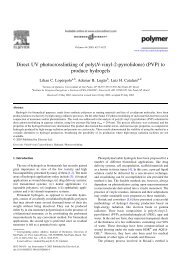
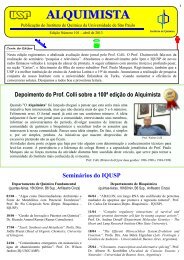
![PE]+ + N. Fragmentação por clivagem sigma](https://img.yumpu.com/50134385/1/180x260/pe-n-fragmentaaao-por-clivagem-sigma.jpg?quality=85)
